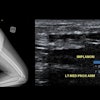
NEW YORK (Reuters Health), Aug 22 - Patients with chronic kidney disease (CKD), particularly those with diabetes mellitus, have a higher risk of contrast-induced nephropathy with a low-osmolar contrast medium than with isosmolar iodixanol, researchers report in the August 15 issue of the Journal of the American College of Cardiology.
Subjects received either intra-arterial iodixanol or a low-osmolar contrast medium. Outcome measurements were the maximum increase in serum creatinine in each group.
Maximum increase in serum creatinine was 0.06 mg/dL with iodixanol compared with an increase of 0.10 mg/dL with the low-osmolar medium. The difference was particularly marked in patients with CKD, who had a maximum creatinine increase of 0.07 mg/dL with iodixanol compared with 0.16 mg/dL for CKD patients receiving the low-osmolar medium.
The difference in maximum serum creatinine was strongest in patients with both CKD and diabetes, with a maximum increase of 0.10 mg/dL with iodixanol compared with an increase of 0.33 mg/dL for low osmolar contrast media.
Contrast-induced nephropathy was defined as a serum creatinine increase of 0.50 mg/dL within three days of administration of the contrast medium. This occurred in 1.4% of patients receiving iodixanol compared with 3.5% of patients receiving a low-osmolar contrast medium.
The odds ratio for contrast-induced nephropathy with a low osmolar contrast medium was 2.6 compared with iodixanol. The odds ratio for CKD was 3.1 with the low osmolar medium compared with iodixanol. The odds ratio for CKD plus diabetes was 2.7 for the former medium compared with the latter.
Diabetes alone was not a significant risk factor in contrast-induced nephropathy.
Dr. McCullough told Reuters Health that "iso-osmolar is safer since it has less osmolarity and causes less kidney injury.... Patients should be screened by questionnaire and/or lab testing for kidney disease and diabetes prior to contrast exposure. For patients at high risk of kidney injury, iso-osmolar contrast is preferable to low-osmolar contrast."
By Martha Kerr
Last Updated: 2006-08-21 15:34:58 -0400 (Reuters Health)
J Am Coll Cardiol 2006;48:692-699.
Related Reading
Elderly need less contrast for pancreatobiliary imaging, August 2, 2006
Assessing patient risk will help prevent contrast-induced nephropathy, June 15, 2006
Copyright © 2006 Reuters Limited. All rights reserved. Republication or redistribution of Reuters content, including by framing or similar means, is expressly prohibited without the prior written consent of Reuters. Reuters shall not be liable for any errors or delays in the content, or for any actions taken in reliance thereon. Reuters and the Reuters sphere logo are registered trademarks and trademarks of the Reuters group of companies around the world.
















